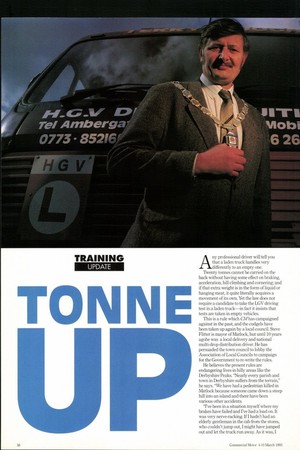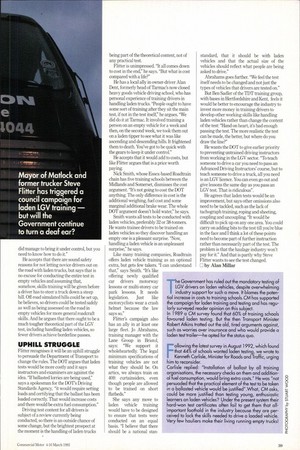TOININ Mayor of Matlock and former trucker Steve Flitter has
Page 40

Page 41

If you've noticed an error in this article please click here to report it so we can fix it.
triggered a council campaign for laden LGV training — but will the Government continue to turn a deaf ear? Any professional driver will tell you that a laden truck handles very differently to an empty one.
Twenty tonnes cannot be carried on the back without having some effect on braking, acceleration, hill climbing and cornering; and if that extra weight is in the form of liquid or hanging meat, it quite literally acquires a movement of its own. Yet the law does not require a candidate to take the LGV driving test in a laden truck—in fact it insists that tests are taken in empty vehicles.
This is a rule which CM has campaigned against in the past, and the cudgels have been taken up again by a local council. Steve Flitter is mayor of Matlock, but until 10 years agohe was a local delivery and national multi-drop distribution driver. He has persuaded the town council to lobby the Association of Local Councils to campaign for the Government to re-write the rules.
He believes the present rules are endangering lives in hilly areas like the Derbyshire Peaks. "Nearly every parish and town in Derbyshire suffers from the terrain," he says. "We have had a pedestrian killed in Matlock because someone came down a steep hill into an island and there have been various other accidents.
"I've been in a situation myself where my brakes have failed and I've had a load on. It was very nerve-racking. If I hadn't had an elderly gentleman in the cab from the stores, who couldn't jump out, I might have jumped out and let the truck runaway. As it was, I did manage to bring it under control, but you need to know how to do it."
He accepts that there are sound safety reasons for not letting novice drivers out on the road with laden trucks, but says that is no excuse for conducting the entire test in empty vehicles and assuming that, somehow, skills training will be given before a driver has to steer a truck down a steep hill. Off-road simulated hills could be set up, he believes, so drivers could be tested safely as well as being assessed on the road in empty vehicles for more general roadcraft skills. And he argues that there ought to be a much tougher theoretical part of the LGV test, including handling laden vehicles, so fewer drivers achieve borderline passes.
UPHILL STRUGGLE Flitter recognises it will be an uphill struggle to persuade the Department of Transport to change the rules. The DOT argues that laden tests would be more costly and it says instructors and examiners are against the idea. "If ballasted lorries are being used," says a spokesman for the DOT's Driving Standards Agency, "it would require setting loads and certifying that the ballast has been loaded correctly. That would increase costs and there would be extra fuel consumption."
Driving test content for all drivers is subject of a review currently being conducted, so there is an outside chance of some change, but the brightest prospect at the moment is the handling of laden trucks being part of the theoretical content, not of any practical test.
Flitter is unimpressed. "It all comes down to cost in the end," he says. "But what is cost compared with a life?"
He has a local ally in owner-driver Alan Dent, formerly head of Tarmac's now closed heavy goods vehicle driving school, who has personal experience of training drivers in handling laden trucks. "People ought to have some sort of training after they sit the main test, if not in the test itself," he argues. "We did do it at Tarmac. It involved training a person on an empty vehicle for a week and then, on the second week, we took them out on a laden tipper to see what it was like ascending and descending hills. It frightened them to death. You've got to be quick with the gears to keep it under control."
He accepts that it would add to costs, but like Flitter argues that is a price worth paying.
Nick Smith, whose Essex-based Roadtrain chain has five training schools between the Midlands and Somerset, dismisses the cost argument. "It's not going to cost the DOT anything. The only difference in cost is the additional weighing, fuel cost and some marginal additional brake wear. The whole DOT argument doesn't hold water," he says.
Smith wants all tests to be conducted with laden vehicles, preferably 32 or 38-tonners. He wants trainee drivers to be trained on laden vehicles so they discover handling an empty one is a pleasant surprise. "Now, handling a laden vehicle is an unpleasant surprise," he says.
Flitter's campaign also has an ally in at least one large fleet. Jo Abrahams, training manager with the Lane Group in Bristol, says: "We support it wholeheartedly. The legal minimum specifications of training vehicles are not what they should be. On artics, we always train on 40ft curtainsiders, even though people are allowed to be trained on short flatbeds."
She says any move to laden vehicle training would have to be designed to ensure that tests were conducted on an equal basis. "I believe that there should be a national stan standard, that it should be with laden vehicles and that the actual size of the vehicles should reflect what people are being asked to drive."
Abrahams goes further. "We feel the test itself needs to be changed and not just the types of vehicles that drivers are tested on."
But Ben Sadler of the TDT training group, with bases in Hertfordshire and Kent, feels it would be better to encourage the industry to invest more money in training drivers to develop other working skills like handling laden vehicles rather than change the content of the test: "Hand on heart, it's bad enough passing the test. The more realistic the test can be made, the better, but where do you draw the line?"
He wants the DOT to give earlier priority to preventing untrained driving instructors from working in the LGV sector. "To teach someone to drive a car you need to pass an Advanced Driving Instructors' course, but to teach someone to drive a truck, all you need is an LGV licence. You can even go out and give lessons the same day as you pass an LGV test. That is ridiculous".
He agrees that laden tests would be an improvement, but says other omissions also need to be tackled, such as the lack of tachograph training, roping and sheeting, coupling and uncoupling. "It would be difficult to pick up on any one area. You could carry on adding bits to the test till you're blue in the face and I think a lot of these points need to become part of further instruction rather than necessarily part of the test. The problem is that the haulage industry won't pay for it." And that is partly why Steve Flitter wants to see the test changed. by Alan Millar he Government has ruled out the mandatory testing of LGV drivers on laden vehicles, despite overwhelming industry support for such a move. It blames the potential increase in costs to training schools.CM has supported the campaign for laden training and testing and has regularly surveyed reader opinion on this subject. In 1 989 a CM survey found that 60% of training schools favoured laden testing. But the then Transport Minister Robert Atkins trotted out the old, tired arguments against, such as worries over insurance and who would provide a laden test trailer—he opted for the status quo.
ollowing the latest survey in August 1992, which found that 44% of schools wanted laden testing, we wrote to Kenneth Carlisle, Minister for Roads and Traffic, urging him to reconsider.
Carlisle replied: "Installation of ballast by all training organisations, the necessary checks on them and additional fuel consumption, would bring extra costs." He was "not persuaded that the practical element of the test to be taken in a ballasted vehicle would be justified" .What, CM asks, could be more justified than testing young, enthusiastic learners on laden vehicles? Under the present system their hard-won test certificates often fail to get them that allimportant foothold in the industry because they are perceived to lack the skills needed to drive a loaded vehicle. Very few hauliers make their living running empty trucks!
















































































